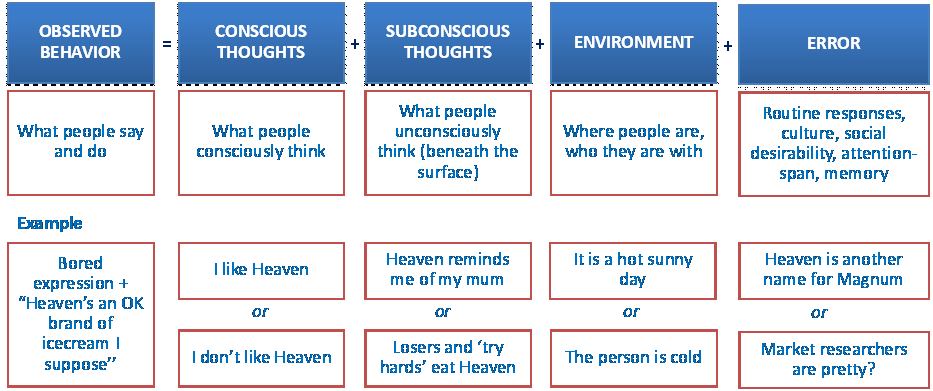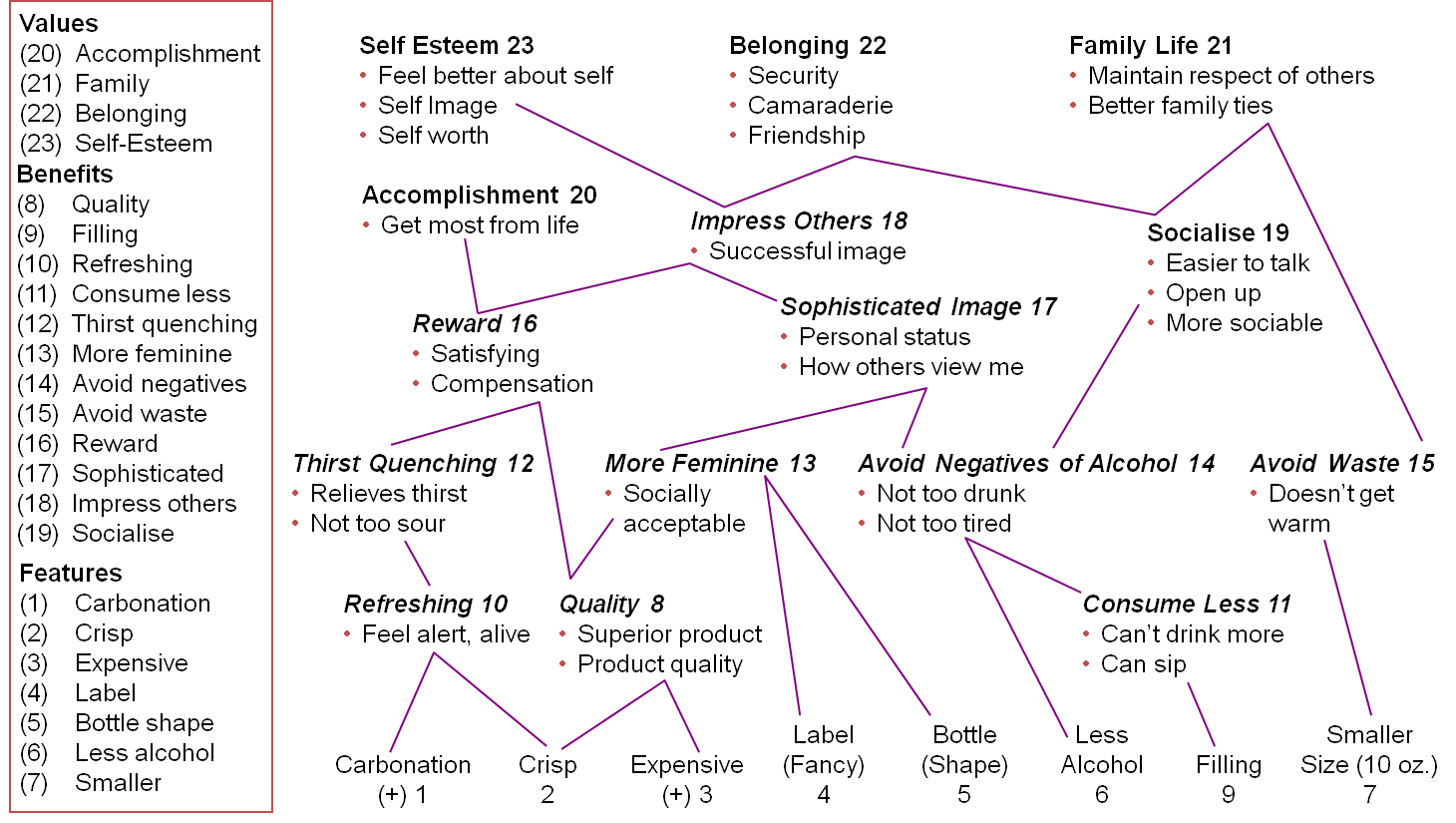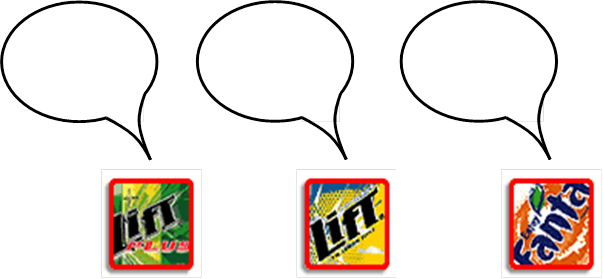Qualitative Research
What is Qualitative Research?
Qualitative research is a catch-all term which refers to all forms of research that do not involve storing data in data files. Most qualitative research, however, involves a combination of:
- Crude quantitative research, where the researcher has insufficient knowledge to conduct a quantitative study so instead conducts a discussion, observes behavior or does something else in an attempt to gain more knowledge. Such research is often a precursor to a quantitative study.
- Probing into underlying needs and wants that are unable to be discovered using quantitative research.
In the US and Asia the focus tends to be more on the first aspect, whereas in the UK, Europe and Australia the focus is more on the second.
In-depth interviews and focus groups
The vast majority of commercial qualitative research involves interviews. A discussion guide is used to structure the interview. Where there is one interviewer and one participant the interview it is called a ‘depth’, which is short for ‘in-depth interview’. As the name suggests, such interviews are typically conducted when it is believed that a detailed discussion is required. Such interviews typically go for about 45 minutes, but this can vary.
Where there is a desire to involve participants in discussion among themselves, or to achieve economies of scale, multiple participants may be involved. Where the interview involves two participants it is a called a ‘paired depth’. With three to five participants the interview is sometimes known as a ‘mini-group’.
A ‘group’, which is short-hand for a ‘focus group’ and ‘group discussion’, is an interview which typically involves one interviewer and from four to sixteen respondents. Six-to-eight is typical when the focus is on probing. Larger group sizes are sometimes used when conducting a crude form of quantitative research.
Moderators and observers
The person who conducts the interview in a group discussion is known as the ‘moderator’. Where the qualitative research is focused on probing to understand underlying needs and wants, the moderator is typically also the person responsible for observing and interpreting the discussions. Where the study is more of a crude quantitative study, it is common that the primary responsibility for observing and interpreting the discussions resides with an observer who is watching either by one-way mirror or a video-link.
Analysis
There is no agreement among practitioners about how best to analyze qualitative research data. Common methods include:
- Reflecting upon the interviews and drawing a conclusion (i.e., no formal process).
- Reading through transcripts and identifying salient quotes.
- Coding, sometimes with the aid of computer programs developed specifically for this purpose.
The subconscious
There are many situations in which people are unable to answer the questions of interest. For just about anything that people eat and drink, if people are asked why they buy what they buy, they say that it is because they “like it”. Although this answer is obviously true, it is incomplete. Consider, for example, choice of brands of beer and cola. When blind taste tests are conducted, people often prefer brands different to those they regularly buy, but when the taste tests are done with the labels on packaging, people invariably say the brand they normally buy, or aspire to buy, tastes best.
A basic framework for trying to disentangle motivations is to view behavior – where an initial answer to a question is an example of a behavior – as being explained by a combination of:
- Conscious thought.
- Subconscious thought.
- The environment.
- Error (random factors which do not really have any meaning).
Two examples are in the following diagram:

Sample Sizes for Qualitative Research
Sampling for qualitative research is completely different than sampling for quantitative research. It is not unusual for qualitative studies to have tiny samples. To understand the impact of sample size on qualitative studies, we will briefly pretend they are quantitative (see Determining The Sample Size for a discussion of sample sizes for quantitative surveys). Imagine a study where we are evaluating two new products, and the first of these products is a clear winner with 75% of people preferring it. With a single focus group of eight people we can compute the confidence interval as 35% to 97%. If we conduct two focus groups the confidence interval becomes 48% to 93%, so we still cannot even be sure that the product that was the clear winner is actually most preferred. With four focus groups, and a sample of 32, the confidence interval is 57% to 89%.
The true confidence intervals for qualitative research are actually much larger than this, as researchers rarely count the number of people to prefer a concept, instead relying upon their perceptions of the overall vibe of respondents, which adds more noise. Further, the samples that are recruited for qualitative research can be quite unrepresentative, which adds yet more uncertainty to any result.
The poor precision of qualitative studies means that a greater level of discipline is required when interpreting qualitative research. Qualitative studies should not be used for estimation. That is, they should not be used to pick winning concepts or to understand what people like (which are both estimation questions). Qualitative studies can, however, identify bad ideas: if nobody likes a concept, then it is very unlikely to become popular with a bigger sample.
As discussed in the introduction, market research involves estimation and explanation. What qualitative research lacks in rigor for estimation it makes up for in its improved ability to explain things (i.e., to create new models). Of course, estimation and explanation are not independent. A degree of caution is required when obtaining explanations from qualitative studies, as the problems of precision make it impossible to be certain about the accuracy of any models derived from qualitative research. For this reason, it is common to use quantitative research to confirm any important findings from qualitative research. However, many firms rely solely on qualitative research when conducting branding and advertising research, as often quantative methods are considered poor for such research.
Discussion Guide
A list of topics to be discussed during. In some circumstances this can be almost as detailed as a questionnaire. In other examples the discussion guide may be a few dot points.
Health care example
I. Welcome and introductions II. Current health status and medical problems III. When do you go see a doctor? IV. Relationship with health care providers Kinds of contact/time spent Difficulty in seeing doctor/making appointments Cost Ease in getting to provider V. Physical examinations Does doctor explain what is happening? Can you influence what tests are performed? How are results communicated? How is the decision made to get a physical exam?
Techniques
Whereas in quantitative research extensive attention is paid to creation of the questionnaire, in qualitative interviews effort is put into the selection of appropriate techniques to permit detailed exploration of the points in a discussion guide.
Techniques commonly used include:
Probing
Probing involves an interviewer asking follow-up questions designed to obtain more and deeper information. It is conducted in a conversational style. Some people believe that probing can elicit people’s sub-conscious motivations. An example of probing is:[1]
Respondent: When I bought my new Mazda, I felt, “What a bargain!”
Interviewer: I hear what you thought, but what did you feel?
Respondent: Well, I felt that the price was fine.
Interviewer: And what did you feel?
Respondent: You know, I felt a little cheap.
Sorting
Sorting, also known as card sorting, simply involves asking participants to sort objects (e.g., brands) according to which are most similar and to explain what makes different objects similar and dissimilar.
Laddering
Laddering is a type of probing which is based around the idea that values determine the benefits that we seek, which in turn determines which features we seek when buying products: Values -> Benefits sought -> Features
Example
Moderator: Why do you like Lemon Ruski?
Jenny: I like it because it’s less alcoholic than having a straight spirit
Moderator: What makes that important to you?
Jenny: It stops me getting too drunk and tired
Moderator: What benefit does this provide to you?
Jenny: Otherwise I might look like a slag – it’s important to appear sophisticated
Moderator: Sophisticated?
Jenny: Well … I like to impress others. It’s good for my self-esteem and it’s important to have the respect of your friends
Hierarchical value map
A key output that can be created by laddering is a hierarchical value map. The example shown below is from the wine cooler market (the precursor to today’s alcopop and RTD markets).[1] The basic idea behind such research is that consumers’ demand for particular products is driven by their basic value system. We start from the bottom of the ladder, which lists the product features, which are linked to benefits which are, in turn, linked to values.

Projective Techniques
Projective techniques seek to get to the subconscious. They work as follows:
- Participants are asked to project their feelings and thoughts onto other things. For example: If Coca-Cola was an animal, which animal would it be?.
- Participants are then asked to explain their answers. This ‘why’ question is the important part of using projective techniques, as the projective techniques are designed to release the sub-conscious thought rather than to be, in themselves, revealing. Probing is used to try and uncover the real explanations. For example, if a Coca-Cola was seen as a cow, the explanation may be that the respondent sees it as fat, slow moving and uninspiring.
Projective techniques are fun. They are widely used, with clients, respondents and researchers all finding them a welcome change from the humdrum of traditional market research questions. However, considerable care needs to be used when asking such questions. As with measuring abstract things, our inability to phrase a perfect question causes confusion between truth and error. Measuring the subconscious is obviously much more difficult than measuring something abstract, as the problem of abstraction is that it is hard to find the right words, whereas the problem with the subconscious is that people do not even think about it.
Projective techniques were developed in psychology. Concerns about their reliability have caused them to be, by and large, the provenance of ‘alternative’ psychology practitioners. In market research they remain mainstream, as other techniques often fail to generate any insight at all into brand buying. Of course, being perceived as useful does not solve the problem of validity. Three things are done to prevent spurious conclusions:
- Probing is used to confirm any interpretations.
- Multiple techniques are used, and results are considered reliable when the same conclusions are drawn from multiple techniques (which is equivalent to the approach to abstract things, where multiple questions are asked).
- Combining the data of multiple people (although almost all qualitative research makes this assumption it is, somewhat inexplicably, rarely mentioned). If the same responses are obtained from lots of people, then it follows that the responses likely contain a kernel of truth. From a theoretical perspective, combining the answers of multiple people to one question is equivalent to getting one person to answer multiple questions if it is assumed that the differences between the people are random and the differences between how a person answers multiple questions are also random.
Sentence Completion
Sentence completion is a projective technique that involves asking participants to complete sentences. For example:
People who buy Coke are _______ I only buy Diet Coke when _______ If my wife brought home a case of VB I’d say _______ People who are concerned out additives and preservatives in food are _______ I think women who buy frozen pastry are probably_______
They are then asked to explain why they have completed the questions in the way that they have completed them.
Cartoon Completion
Cartoon completion is a Projective Technique which asks participants to write in the bubble of a cartoon: and then to explain what they have written.

Stereotyping
Stereotyping is a Projective Technique that involves presenting a description of people, either using words or images, and asking people questions about the topic of interests. For example:
- What soft-drinks would these families have in the house?
- What brand of bubble gum is she chewing?
This is then followed up with a probing question in which the participants are asked to explain their answers (e.g., What makes you think that?)
Example word descriptions
Family A: Both are about 30 years of age with two young children and are very much concerned about owning things. They desperately want a better lifestyle, so he works hard, often for overtime pay, in order to be able to achieve this. She is planning to return to work, part-time, as soon as possible. They spend time furnishing and decorating their home as they are very house proud. When it comes to buying things, they are more influenced by looks than anything else. They watch TV and read an average amount and tend to follow trends once they have already become fashionable. They think of themselves as modern and up-to-date, but are really quite conventional with regard to family life. They fall into the medium income bracket.
Family B: Husband and wife are in their early fifties with one married son and a 19-year old-daughter. Mr B. works at a boring job and is grateful for the money, which pays for the basic necessities of life. Mrs B does not work, so they do not do much in their leisure time because they cannot afford it. He enjoys football and gambling; she bingo. They watch TV a great deal. They feel that life is hard nowadays, and owe a lot of money. They buy on price – the cheapest possible. Their attitude to their family is traditional, and so are their political and social views. They are climate sceptics.[2]
Brand Personification
Brand personification is a Projective Technique that asks people to think about brands as if they were people and to describe how the brands would think and feel. For example:
If these three brands were at a party, what would they be saying to each other?

Brand personification questions are followed up by questions designed to understand the personification: Why do you say that?
Alternative versions of this method ask for the brand to be described as a person, animal, car, celebrity or house. Some researchers ask respondents to create collages of photos to represent the brand, or, present people with a set of photos and ask which photo shows a person most likely to buy the brand.
Some researchers use versions of the question where respondents are shown photos of the same or a similar-looking person with different hairstyles and clothes (e.g., one as a yuppie, one as a housewife), and these photos are believed to represent archetypal personality types. There is no published evidence to suggest that these methods work, but it is unclear if this is because they do not work, or because the researchers who use these questioning methods wish to protect their intellectual property.
- Sudman, Seymour and Edward Blair (1998), Marketing Research: A Problem-Solving Approach. New York: McGraw Hill, p. 187.
- Adapted from Gordon, Wendy and Roy Langmaid (1988), Qualitative Market Research: A Practitioner’s and Buyer’s Guide. Aldershot: Gower, p. 105.


